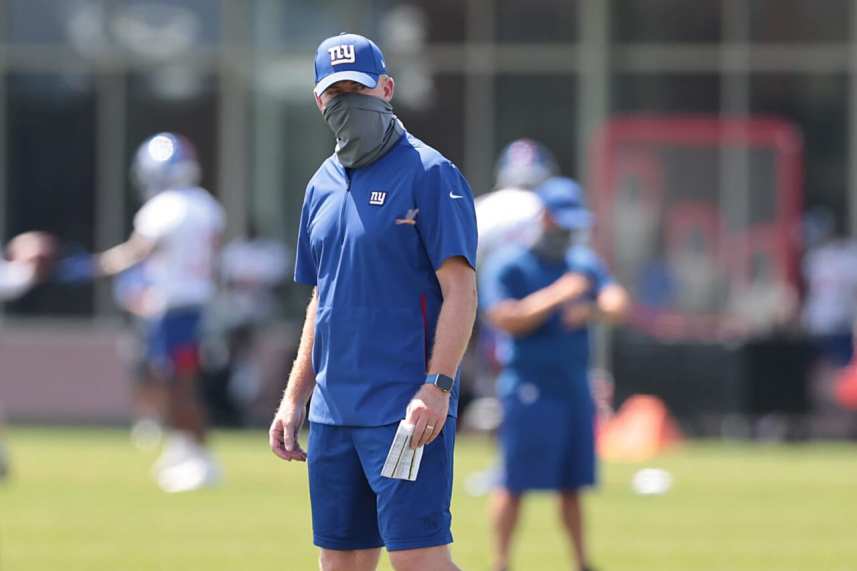
The New York Giants have more problems on offense than they can possibly solve in one off-season. However, they entered the 2020 campaign with high expectations regarding their offense’s capabilities. With adequate wide receivers and high expectations for second-year quarterback Daniel Jones, they weren’t supposed to be second to last in points per game this year.
Fast forward to week 16, and the Giants are currently averaging 17.4 points per game and a measly 185.7 passing yards per game. It is clear that Big Blue has a lot of work to do before they can institute a competent offense in the modern-day NFL, but let’s take a look at who’s at fault and where the Giants should be placing the blame.
Ranking the New York Giants’ weaknesses on offense:
1.) Jason Garrett
One thing is clear, offensive coordinator Jason Garrett deserves a majority of the blame for the Giants’ struggles on offense. While the wide receivers have failed to create ample separation, his route combinations are extremely limited and oftentimes poor. Just take a look at the clip below, which shows four receivers running routes under 5 yards, failing to stretch the field and take players out of coverage.
Guys, prepare for ANGER.
~This is Jason Garrett Vs Kevin Stefanski~
Garrett: Giants run 2 curls on bottom, EE runs hook, Slayton runs hook, Rb runs flat…NO SPACE.
Stefanski: Browns run outside WRs verts to clear out DBs, takes 3 DBs out of the play, Hooper Vs Carter Coughlin pic.twitter.com/pEC5GBXXpG
— Alex Wilson (@AlexWilsonESM) December 23, 2020
When looking at alternative offenses with more downfield routes, you can see that they draw defensive backs out of coverage and open up better probability throws underneath. For example, against the Cleveland Browns, head coach Kevin Stefanski ran two hooks with their tight ends from the slot position, pushing his boundaries wide receivers on go-routes, which took three defensive backs out of coverage and allowed his tight ends to get open in-between zones.
If there’s anything to like about Garrett’s system, it is his running game. The Giants have seen their running attack improve tenfold this year, but the passing remains a serious problem that must be solved. Even with Freddie Kitchens as the OC this past weekend, we saw the offense take more shots downfield and stretch the field. If not for two failed attempts on fourth down, the day would’ve looked a lot better for Kitchens and his playcalling sequence.
Garrett seems to be extremely conservative in the category, and if he is unwilling to push his receivers downfield and utilize a more vertical game, the Giants should seriously consider replacing him in 2021.
2.) Daniel Jones
While I do think Daniel Jones’ struggles are a primary result of Garrett’s poor playcalling, there are some troubling factors to consider. Jones still struggles with moving through his progressions adequately, sometimes failing to reach his second and third options.
Take a look at the clip below, which shows a wide-open Dion Lewis in the flat on the bottom left — DJ never sees him.
Going back to Arizona game for a second — There's A LOT wrong with the Giants' offense, and this is part of it.
Daniel Jones' inability to read progressions and move on from his 1st/2nd reads.
Dion Lewis is WIDE OPEN on the bottom right, instead, DJ throws a TERRIBLE ball. pic.twitter.com/TJS4juhIug
— Alex Wilson (@AlexWilsonESM) December 23, 2020
Plays like this are unacceptable for a second-year quarterback in the NFL, as Jones fails to move on through his progressions and instead throws a terribly risky ball to Evan Engram in the flat with a defender underneath. Mental lapses like this cannot continue if the Giants want to commit to Jones for the future, and this type of decision making is not scheme related all the time.
However, Jones has cut back tremendously on his fumbles and protected the ball a bit better compared to 2019. He enjoyed three games last year with 4+ touchdowns, indicating he can throw the ball extremely well, but the playcalling must be fantastic. Ultimately, the Giants have done Jones zero favors in his progression and development, and unless they bring in a downfield oriented coordinator to maximize Daniel’s strengths, they will simply run him into more injuries with his legs.
3.) Lack of playmakers/wide receiver separation
The offense’s inability to score points is a direct result of playcalling, but when your wide receivers can’t create separation and get open, it makes it a bit difficult for the quarterback.
Losing Saquon Barkley early in the season significantly hurt the Giants’ ability to draw attention from opposing defenses and force them to stack the box. When Saquon is active and healthy, defenses need to keep linebackers monitoring the run, which opens up the middle of the field. Opposing teams simply aren’t afraid of Wayne Gallman and Alfred Morris, despite the Giants seeing an improvement in rushing yards per game this season.
When Saquon eventually makes his return in 2021, the Giants should experience an uptick in offensive efficiency, specifically when it comes to passing the football. On one play against Cleveland, the New York Giants gave up a first down on a drag route to TE Austin Hooper, and this was a direct result of multiple players spying on running back Kareem Hunt.
Hunt essentially took Jabrill Peppers and Logan Ryan out of the play, indicating the influence a talented back can have for your offense. That is what the Giants are lacking without Saquon, so his reinstallation will provide a major boost one way or another.